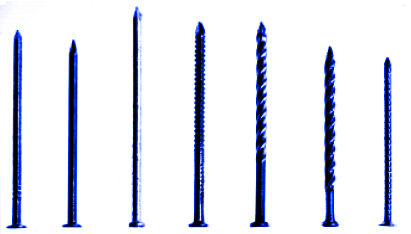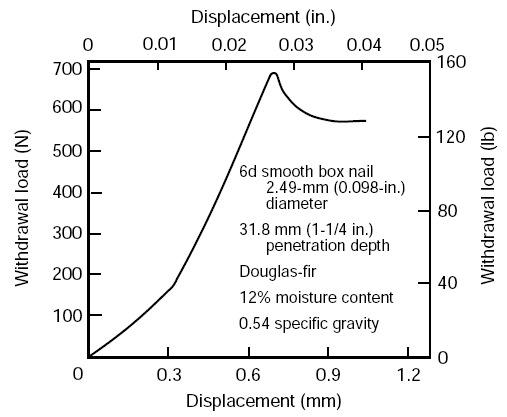Related Resources: calculators
Wood Nail Pullout Withdraw Resistance Force Formulae and Calculator
Strength Mechanics of Materials
Beam Deflections, Stress Analysis and Engineering
Civil Engineering and Design
Wood Nail Pullout Withdraw Resistance Force Formulae and Calculator

Various types of nails: (left to right) bright
smooth wire nail, cement coated, zinc-coated, annularly
threaded, helically threaded, helically threaded and
barbed, and barbed.
Preview: Wood Nail Pullout Withdraw Resistance Force Calculator
The resistance of a nail shank to direct withdrawal from a piece of wood depends on the density of the wood, the diameter of the nail, and the depth of penetration. The surface condition of the nail at the time of driving also influences the initial withdrawal resistance.
Experimental Pullout Loads:
For bright common wire nails driven into the side grain of seasoned wood or unseasoned wood that remains wet, the results of many tests have shown that the maximum withdrawal load is given by the empirical equation
p = 54.12 G2 D L (Metric screws)
p = 7,850 G2 D L ( inch-lbs)
Where:
p = Maximum withdrawal load (N, lb),
G = Specific gravity based on ovendry weight and volume at 12% moisture content,
D = Ddiameter of the nail (mm, in.),
L = Length of penetration of the nail into the wood (mm, in.).
The loads expressed by the above Equation represent average data. Certain wood species give test values that are somewhat greater or less than the equation values. A typical load– displacement curve for nail withdrawal (Fig. A) shows that maximum load occurs at relatively small values of displacement.

direct withdrawal of a nail.
Related web pages:
- Standard Nail Size Table Chart and Nail Terms
- Wood Engineering Properties (Specific Gravity) for Hardwoods
- Wood Engineering Properties (Specific Gravity) #2
- Wood Engineering Properties (Specific Gravity) #3 Engineering Properties
- Structural Wood Lumber Engineering Properties Table Chart | Modulus of Elasticity of Wood | Wood Engineering Design Data | Elastic ratios
- Density of Wood Equation and Calculator
- Common Nails Required for Rafter Ceiling Joist Heel Joint Connections
- Commercial Lumber Sizes Chart Table
Special Note to Non-Engineers
We think it's great that you're here on Engineers Edge, but know that this technical data is written for engineers and designers. Engineers Edge is an engineering and design consulting, training and publishing firm and does not provide extended support to our general website visitors. There is a feedback form available and any and all professional comments are welcome.
References:
- AF&PA. 1997. National design specification for wood construction. Washington, DC: American Forest & Paper Association.
- ASCE. 1995. Standard for load and resistance factor design (LRFD) for engineered wood construction. Washington, DC:
- American Society of Civil Engineers. ASCE. 1996. Mechanical connections in wood structures. Washington, DC: American Society of Civil Engineers.